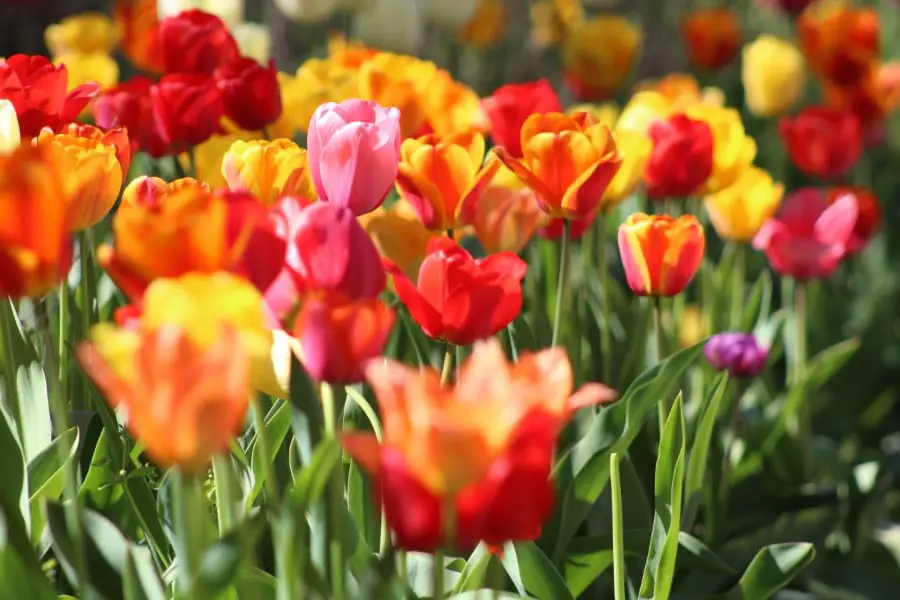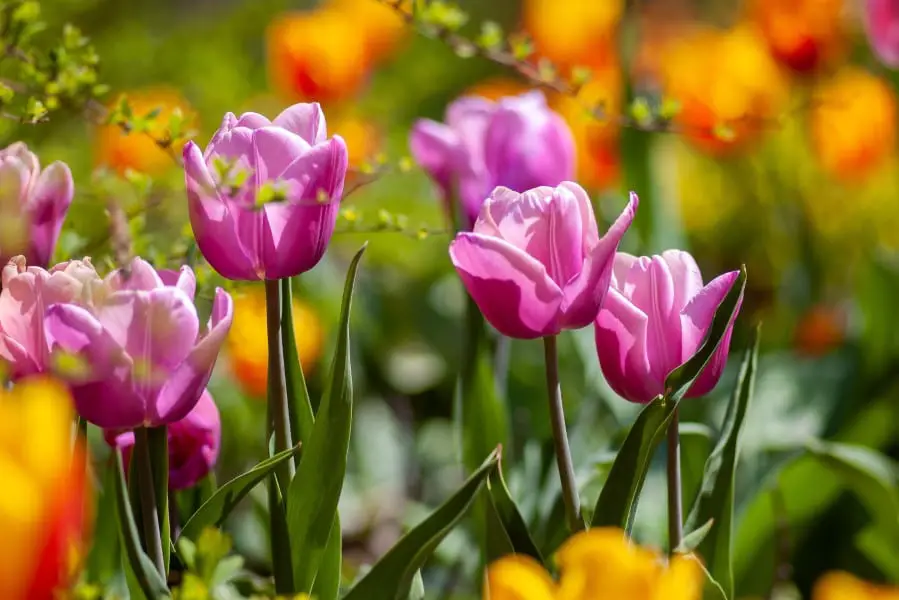I love to grow tulips. A tulip bulb is a perfect package that contains the promise of beautiful flowers ready to burst out when the warmer weather comes.
If you’re like me and have been gifted, or bought tulip bulbs too late to plant, then here are 2 methods to plant them in springtime and give them a good chance to successfully bloom in the same year.
Tulip bulbs are hardy, as opposed to a tender bulb. A hardy bulb can survive outside in well drained soil all year round, even in harsh winter.
The winter is when bulbs are in their resting stage, this gives it the chance to gather all the nutrients, and energy it needs to grow strong and beautiful in spring
And this is why most gardeners recommend planting tulip bulbs in the cold of autumn or winter…
So, can you plant tulips in spring? You can. There are two ways to do this. If conditions are right, plant them straight outdoors, if not, use the force blooming method. Both methods need cold and moisture for successful blooms in the same year. Heres how to decide which is best for you, and how to plant tulips outside or in pots
For thousands of years, farmers and gardeners have learned that seasonal weather change plays a huge part in knowing the best time of year to sow, grow and harvest their flowers and crops. This ensures they get the best quality and quantity from what they’ve planted.
With this knowledge, seed, bulb and fauna sellers put this growing information on the packets we buy. This gives us the best chance of successfully growing our flowers so we’re happy with the outcome.
Having this knowledge for ourselves gives us the chance to plant our tulip bulbs during late winter or spring, and also enjoy their blooms in the same year.
So, before I take you through how to plant your tulips in spring, here’s a little about the tulips growth life cycle, and how we can use that knowledge to create the right conditions into fooling our bulbs into growing earlier and in a healthy way.

The Life Cycle of a Tulip
As we’ve gathered, a bulb is a self contained powerhouse of nutrients and energy. It also has the genetic information to become a tulip. It knows what time of year to rest, grow roots, sprout leaves, a stem and when to form a bud and bloom.
Tulip bulbs are usually planted in late autumn or early winter. This gives them 3 to 4 months to gather nutrients from the soil. They store these nutrients then become activated when the warmer weather comes.
The stored nutrients help grow strong and healthy roots, leaves, stems, and eventually buds that bloom in spring.
As summer approaches tulips have usually finished growing and flowering. Their leaves, stems, and blooms wither down. When this happens its time to cut the withered foliage to the level of the ground. This is when our tulip bulb starts to regenerate.
No longer needing to feed the growing tulip above the ground, the bulb can now concentrate on gathering all the nourishments the soil can provide. This happens throughout the warm summer and early autumn months.
As winter approaches, tulip bulbs go into their resting period. The cold weather stops them from sprouting too early. Lying in wait, they carry on growing stronger and hardier.
Then, in springtime, as the warmer weather draws in they once again burst into action growing roots, leaves, stem, bud, and bloom out of its perfectly packaged bulb.
Now that we know how tulips grow and regenerate, we can see why it’s unusual to plant tulip bulbs in spring and have them grow the same year.
Understanding what conditions tulips need to grow successfully can help us coax them into believing its time to start growing, even when they’ve been planted too late.
So, here are 2 methods I’ve had great success with to fool tulips into thinking it’s time to start growing.
Method 1
Tulip Planting Outdoors in Spring Depending on the Weather
This method requires a little judgment on your part about the weather you’re experiencing during your own springtime. Usually, it’s starting to warm up, and as we know, tulips need a cold resting period in order to kick start their growing cycle.
So, if it’s still wintery cold outside and you’re assured of at least 2 weeks or more of bitterly cold weather for your bulbs to regenerate, then go ahead and plant your bulbs.
Yes, its that simple.
But, If your springtime has already started to warm up, then have a go at Method 2 below.
For method 1, if you’re happy with the weather conditions, use the planting instructions that your tulip bulbs came with. However, if you’ve been gifted or bought your bulbs without planting information here’s how to do it.

How to Plant Tulips Bulbs
Top Tip: Although tulips can grow quite happily in full sunshine, they’ll be fine in partial shade too. Make sure the ground isn’t waterlogged and has good drainage.
- Choose the site, or pot you want your tulips to grow in
- Dig over the area, and crumble up any large pieces of soil
- Place your tulip bulbs where you want them to grow, in rows or groups
- As a rule of thumb plant each tulip bulb twice their own depth and space twice their width apart
- Lift each bulb, and with a trowel dig a bulb size hole
- With the crown facing up, place the bulb in the hole, and firm over the soil.
- Repeat this for each bulb
TopTip: I always use a marker or label when I’ve planted in bulbs. It’s so easy to forget where they are, and I don’t want to dig and damage the bulbs I’ve planted.
If the weather has started to turn milder and you don’t want to risk the loss of a tulip display, then use method 2 below.
Method 2
Forced Blooming Tulip Bulbs to Flower in Springtime
‘Forced blooming’ is a way of tricking mother nature into thinking the weather conditions are ideal for your tulip bulbs to thrive and flower.
This method does take a bit of patience, but its well worth it when you can proudly say that your tulip display was from bulbs you planted in spring.
- Select firm, well formed tulip bulbs.
- Use clean pots with drainage holes that are 2 to 3 times the depth of your tulip bulbs.
- Put a layer of gravel at the bottom of each pot.
- Layer multi-compost on top of the gravel.
- Arrange and place your tulip bulbs ‘crown up’ (the pointy end up) on top of the compost.
- Fill the rest of the pot with multi-compost and gently water.
- Place the pots in a cold place or refrigerator.
- Keep checking for roots appearing out of the bottom, or shoots from the top.
- When roots or shoots appear, acclimatize your tulips near their growing site.
- Then, gently transplant your tulips, or place the potted tulips where you want them.
- Enjoy your tulip display 🙂
Top tip: When you’re Force Blooming tulips, check them every few days to make sure the compost hasn’t dried out in the pots, keep it moist, but don’t overwater so that the bulbs are sitting in a puddle.

My conclusion
If you’re planting your tulip bulbs in spring, I hope you’ve found these methods useful, and I hope I’ve helped give you the best chance of your tulips flowering this year 🙂
I’m often gifted bulbs during the festive seasons and it’s so pleasing when the giver of my gifts can see them blooming lovely within the same year.
I hope this article has given you a little knowledge and confidence to plant and enjoy your tulips, and other winter bulbs in springtime with success.

